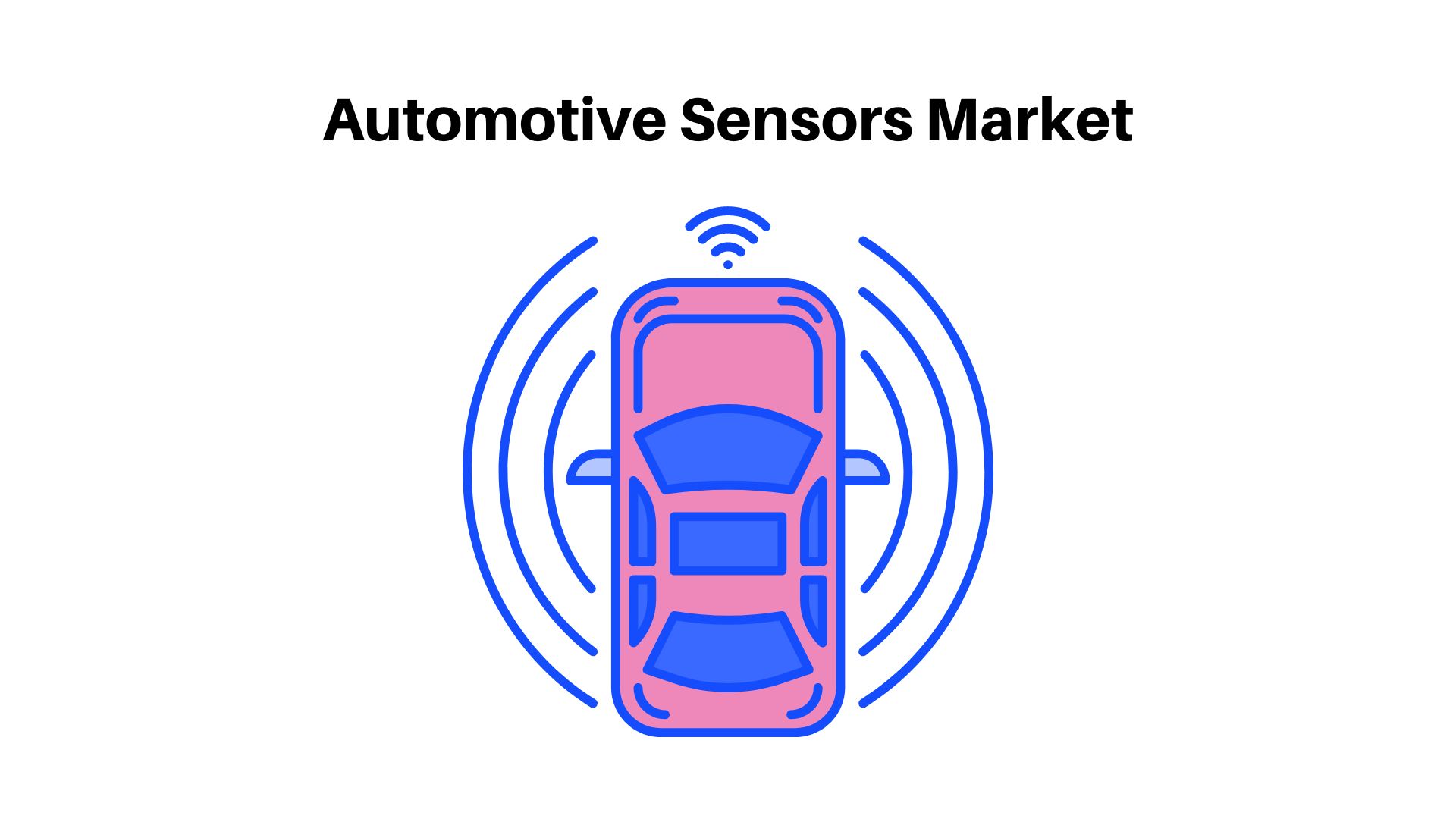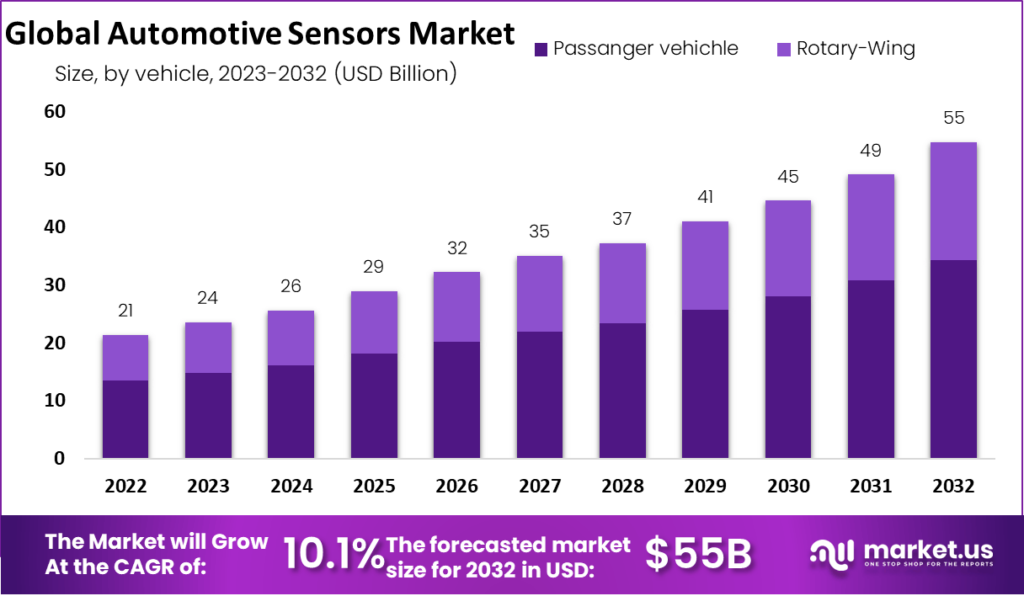10.10% CAGR of Automotive Sensors Market to Reach USD 56.01 billion by 2032

Page Contents
Published Via 11Press: The global automotive sensors market size is expected to be worth around USD 56.01 Bn by 2032 from USD 21.4 Bn in 2022, growing at a CAGR of 10.10% during the forecast period from 2022 to 2032.
The automotive sensors market is set to grow exponentially in the near future. This is due to a series of factors, including the increased demand for autonomous vehicles, the need for enhanced safety features in vehicles, and the development of advanced driver assistance systems (ADAS). Automotive sensors measure a range of parameters such as pressure, temperature, humidity, and motion among others, and provide data for vehicle control systems to ensure optimal performance. The demand for automotive sensors has grown significantly due to increased safety regulations and consumer preferences for automated vehicles.
A wide range of sensors is used in automotive applications, such as radar, LiDAR, ultrasonic sensors, vision sensors, and infrared cameras. These components enable cars to detect obstacles on roads and navigate safely. Furthermore, they help improve performance levels by optimizing fuel efficiency, controlling emissions levels, and improving traction control systems.
According to experts from relevant markets and industries, this growth will be driven primarily by increasing government regulations regarding vehicle safety standards as well as rising consumer awareness about vehicle safety technology. Major players in the automotive sensors market include Robert Bosch GmbH, DENSO Corporation, and Infineon Technologies AG.
Request For Sample Report Here: https://market.us/report/automotive-sensor-market/request-sample/

Key Takeaways
- The automotive sensors market is experiencing tremendous growth due to the rising demand for advanced safety features and enhanced driving experiences.
- Modern vehicles are equipped with automotive sensors that feed vital data to their control systems, enabling them to run safely and efficiently.
- This market is highly competitive. Companies invest heavily in research and development to stay ahead of their rivals.
- The key players in this market include Robert Bosch GmbH and DENSO Corporation.
- The global automotive sensors market is expected to surge from USD 21.4 billion in 2022 to USD 56.01 billion by 2032, expanding at an annual compound growth rate of 10.10% throughout the forecast period.
- This growth is being spurred on by an increasing demand for safety features and the rising popularity of hybrid and electric vehicles.
Market is witnessing the emergence of new technologies like LiDAR, which are being utilized in autonomous vehicles to enhance object detection and navigation. - The automotive sensors market is expanding due to the rise of connected cars. Sensors collect data on vehicle performance, driver behavior, environmental conditions, and more for analysis and insight.
Drivers
Increasing Demand for Advanced Safety Features The demand for advanced safety features such as lane departure warnings, blind spot detection, and automatic emergency braking is propelling growth in the automotive sensors market. These systems use sensors to collect data about their environment and issue warnings or take corrective actions in order to prevent accidents. Growing Popularity of Electric and Hybrid Vehicles With the rise in electric and hybrid vehicle demand, sensors to monitor the performance of their electric drivetrain has become even more essential. These sensors measure things like battery temperature, current flow rate, and voltage; providing data to vehicle control systems so they can optimize performance and efficiency.
Focus on Emission Reduction and Fuel Efficiency There is an increasing emphasis on emissions reduction and fuel efficiency within the automotive industry, driven by regulations and consumer demand. Sensors are being used to measure things like exhaust gas composition and fuel consumption, providing data that helps optimize performance while cutting emissions. Trend Toward Connected Cars As more cars become connected, and equipped with sensors and other technologies that can collect and transmit data about their performance and environment, growth in the automotive sensors market has been spurred. These sensors measure things like vehicle speed, location, and driver behavior – providing data that can be used for predictive maintenance tasks, traffic management strategies, and personalized driving experiences.
Development of New Sensor Technologies The advancements in sensor technologies such as LiDAR and radar are driving growth in the automotive sensors market. These sensors are being utilized in autonomous vehicles for improved object detection and navigation, as well as advanced driver assistance systems (ADAS) like adaptive cruise control and parking assist.
Purchase This Report Via Secured Link and Avail Discount: https://market.us/purchase-report/?report_id=13982
Restraints
High Cost of Sensors Automotive sensors can be expensive, particularly those required for advanced safety features and autonomous driving. This may limit their adoption, particularly in lower-end vehicles. The complexity of Sensor Integration Integrating sensors into vehicles can be a time-consuming and complex process, especially for legacy models that weren't designed with sensors in mind. This may restrict the adoption of advanced sensor technologies in markets. Reliability and Durability Issues Automotive sensors are exposed to harsh environments like high temperatures, moisture, and vibration which may compromise their reliability and durability. This could result in increased maintenance costs as well as potential safety issues if the sensors malfunction.
Cybersecurity Concerns As vehicles become more connected and dependent on sensors and other electronic systems, cybersecurity becomes an increasingly pressing concern. Hackers could potentially access a vehicle's sensor data or control systems, potentially leading to safety issues or other problems. Regulatory Challenges Regulations related to vehicle emissions, safety, and cybersecurity can pose difficulties for the automotive sensors market. Manufacturers must ensure their sensors meet these regulatory requirements which add complexity and costs to the design and production process.
Overall, the automotive sensors market is expected to experience strong growth over the coming years; however, certain obstacles may slow its progress and require manufacturers to address these obstacles in order to remain successful in this space.
Opportunities
Autonomous Driving The development of autonomous vehicles presents a major opportunity for the automotive sensors market. Advanced sensors such as LiDAR, radar, and cameras are necessary for autonomous driving to become more widespread consequently, demand for these sensors is expected to surge significantly. Electric and hybrid Vehicles The growing popularity of electric and hybrid vehicles presents an opportunity for the automotive sensors market. As these vehicles become more commonplace, there will be an increase in demand for sensors that can monitor battery power consumption as well as electric drivetrain performance.
Connected Cars As more vehicles become connected, and equipped with sensors and other technologies that can collect and transmit data, there will be an increasing need for automotive sensors market products. These sensors are useful for things like predictive maintenance, traffic management, and personalized driving experiences thus, as more vehicles become interconnected the demand for these sensors will grow. Innovation in Sensor Technologies Sensor technologies offers exciting potential for innovation, such as new materials, miniaturization, and improved accuracy. These developments could result in new applications for sensors in the automotive industry and increased demand for these sensors. Emerging Markets The automotive industry is growing in emerging countries like China, India, and Brazil. As these economies continue to develop, demand for automotive sensors is expected to rise, offering manufacturers an opportunity to expand their operations in these regions.
Overall, the automotive sensors market offers numerous opportunities for growth and innovation due to emerging technologies, shifting consumer preferences, and expanding markets. Companies that can stay ahead of these trends by innovating within this space are likely to be successful in the years ahead.
Challenges
Intense competition The automotive sensors market is highly competitive, with many players offering a wide range of sensor solutions. This can make it difficult for manufacturers to differentiate themselves and compete on price and quality. Rapidly changing technology The automotive industry is rapidly evolving, with new technologies emerging all the time. This can make it challenging for manufacturers to keep up with changing customer demands and stay ahead of the competition. Design and manufacturing challenges Designing and manufacturing automotive sensors can be complex, requiring specialized expertise and equipment. This can lead to high costs and long lead times, which may limit the ability of manufacturers to respond to changes in the market.
Supply chain disruptions The COVID-19 pandemic highlighted the risks associated with global supply chains, which can be vulnerable to disruptions caused by factors such as natural disasters, political instability, and trade disputes. This can impact the availability of key components and materials needed for sensor manufacturing. Regulatory compliance The automotive industry is subject to a range of regulations related to emissions, safety, and cybersecurity. Compliance with these regulations can be challenging and may require significant investment in research and development, testing, and certification.
Overall, the automotive sensors market faces several challenges that manufacturers must navigate to remain competitive and profitable. Staying ahead of changing technology, managing the supply chain effectively, and ensuring regulatory compliance will be critical for success in the years to come.
Recent Development
- In November 2021, Robert Bosch GmbH unveiled an advanced driver-assistance system designed specifically for city rail transportation. When a potential collision is detected, the system first alerts the tram driver with a signal. If they fail to intervene or do so too late, automatic braking takes over until there is a complete stop to minimize the impact or avoid it entirely.
- In October 2021, Infineon Technologies AG unveiled their automotive current sensor XENSIV TLE4972. Powered by Infineon's well-proven Hall technology, this coreless current sensor offers precise and stable readings of current.
- January 2020 Bosch has begun developing a long-range LiDAR suitable for automotive use. This LiDAR could potentially be employed in autonomous vehicles.
Report Scope
| Report Attribute | Details |
| The market size value in 2022 | USD 21.4 Bn |
| Revenue forecast by 2032 | USD 56.01 Bn |
| Growth Rate | CAGR Of 10.10% |
| Regions Covered | North America, Europe, Asia Pacific, Latin America, and Middle East & Africa, and the Rest of the World |
| Historical Years | 2017-2022 |
| Base Year | 2022 |
| Estimated Year | 2023 |
| Short-Term Projection Year | 2028 |
| Long-Term Projected Year | 2032 |
Key Market Segments
Based on Type
- Temperature Sensors
- Pressure Sensors
- Motion Sensors
- Speed Sensors
- Gas Sensors
Based on Vehicle Type
- Passenger Cars
- Commercial Vehicles
Based on Application
- Powertrain
- Chassis
- Exhaust
- Security
- Telematics
- ADAS
Key Players
- Robert Bosch GmbH
- DENSO Corporation
- Infineon Technologies AG
- NXP Semiconductor
- ST Microelectronics
- Valeo
- Continental AG
- Sensata Technologies
- Delphi Automotive Company
- Texas Instruments Incorporated
- Elmos Semiconductor
Report Scope
| Report Attribute | Details |
| The market size value in 2022 | USD 21.4 Bn |
| Revenue forecast by 2032 | USD 56.01 Bn |
| Growth Rate | CAGR Of 10.10% |
| Regions Covered | North America, Europe, Asia Pacific, Latin America, and Middle East & Africa, and the Rest of the World |
| Historical Years | 2017-2022 |
| Base Year | 2022 |
| Estimated Year | 2023 |
| Short-Term Projection Year | 2028 |
| Long-Term Projected Year | 2032 |
FAQ.
The automotive sensor market is studied from 2017 - 2032.
The automotive sensor market is growing at a CAGR of 10.10%
Asia Pacific is growing at the highest CAGR over 2022- 2032.
North America holds the highest share in 2022.
Robert Bosch GmbH, DENSO Corporation, Infineon Technologies AG, NXP Semiconductor, ST Microelectronics, Valeo, Continental AG, Sensata Technologies, Delphi Automotive Company, Texas Instruments Incorporated, Elmos Semiconductor
The team behind market.us, marketresearch.biz, market.biz and more. Our purpose is to keep our customers ahead of the game with regard to the markets. They may fluctuate up or down, but we will help you to stay ahead of the curve in these market fluctuations. Our consistent growth and ability to deliver in-depth analyses and market insight has engaged genuine market players. They have faith in us to offer the data and information they require to make balanced and decisive marketing decisions.